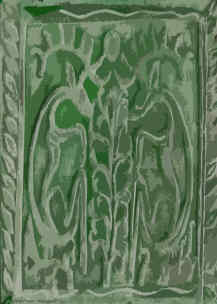Unedited Reviews of Scowan Urla Grun
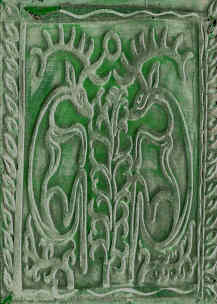
This CD release with a bonus CD comes in a DVD box with artwork with medieval / Gothic / association and ornamental interest. The players and composers are Rachel McCarron and Sean Breadin. It has been recorded during various performances in a chapel. Sean uses very medieval-like forgotten instruments like gardon, an Hungarian string instrument, the koboz, a short-necked lute of Middle East origin, -known in Byzantium as the pandourion, an instrument thatmade its way into neighbouring regions from Persia by means of Islamic conquests and migrations (the Spanish Christians called it a Moorish guitar), and the crwth, which is a Welsh 18th century’s lyre that has similarities with much older lyres. (The lyre itself was build perfectly for the hand that could respond with it in various hand and finger positions. These positions were originally regarded as corresponding with various systems, not only musical systems, but corresponding to cosmogenic positions, to be played in correspondence as well with the spheres and elements, and so on, making music that would respond on different levels at the same time, and moving in harmony with the spheres and positions, or expressing some aspects within the corresponding movements. These methods are somewhat forgotten, but also here are not used this way).
On this CD various 'traditionals' are interpreted with emphasis on the 'mood' they create. Some patterns of simple acoustic repetitions (by the string instruments), small drone patterns (in the first mostly only organ and such, or loop-like patterns), are combined with some improvisation on clarinet, some programmed percussion, and singing. This singing is also very medieval. The voice arrangements here and there are somewhat odd, weird, creating an almost occult sphere (especially on "Thomas The Rhymer"). The tracks are quite long, but this might be to pull you into the dance and drone trance of the mood. Last track falls a bit off the record. In general this CD creates its own sphere well, somewhat trance-like in its approach.
The bonus CD with even longer tracks uses more droning programming. The evolutions are again very minimal, the voice arrangements have more echo and sound a few times ghost-like. There’s a much more brooding drone sphere here and less acoustic instruments. New here is the use of the jazzy 'cornet', bringing in a new fusing mood. On ‘Tamlin’ the voice of Rachel has almost ghost-like effect in the arrangements. In “King Orfeo” Sean’s voice becomes almost native Indian/shaman like in its troubadour story telling. There’s more emphasis on creating some kind of magical mood effect, still the tracks are long, almost too long.
Gerald Wan Waes (Psychedelicfolk Homestead / Winter 2004)

I first heard Venereum Arvum on Infernal Proteus; Ajna's 4-CD hardback musical herbal on which they marked their presence with a ten minute rendering of a traditional English May Carol that scared the bejapers out of me. Here things are less intense, languidly reassuring, yet still that edge of darkness, shadows creeping in the eerie otherness, like staring into a mixed hedge of holly & hawthorn at twilight (which some of us do) if only to catch a glimpse of what else might be lurking there; or else peering up into the rafters of a medieval church to see the Green Man grinning right back at you. Sean is Sedayne, a Northumbrian storyteller - I even saw him perform once, way back in 1995 at The Crick-Crack Club in darkest Islington, keeping a packed house on London trendies absorbed with his singular takes on traditional tales and songs, one of which appears here (King Orfeo) & gives the title to the collection. He was also (as I learned that night in Islington) a founder member of METGUMBNERBONE whose reputation need not be overstated here; likewise he was part of the Metgumbnerbone-derived trio (which also featured TNB's Richard Rupenus no less) that recorded the MASSISHADDHU / SHEKINAH LP for United Dairies in 1998 (re-released on CD by Psychedelic Pig in 2000). So here we have this seriously heavy experimentalist & storyteller wielding his passion for Traditional ballads with a resolve & authority that might have more conventional folkies fearing for their sanity. Best track: THOMAS THE RHYMER in which Rachel sings with the voice of a thousand fairy queens, seductive & beguiling to those with ears to hear. Worst track: SIR OLAF, which really is too normal, too conventionally folksy to be a serious contender in this context, although the Folia wyrds things up a bit - I dare say the Circle Dancers will lap it up! Evident influences: Incredible String Band (just a thought...) Third Ear Band (quite possibly) Sun Ra (reimagined as neo-Celtic inner-space shaman???) Don Cherry (anyone playing pocket trumpet just has to be) The Fall (Sean's a big fan so it's safe to assume & there are some definite HEX inspired moments). Very worthwhile. Good cover too, primal imagery as designed & realized by Sean scanning his own hand cut woodblocks into his computer - is there no end to this man's talents? Only one - self-publicity!
Siamang Gibbons (Asinaria Festa / Summer 2004)
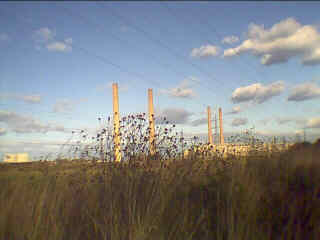
Proximal Indo-European No-Age Exotica. There-that got your attention, didn't it? The above is how Venereum Arvum-the duo of Sean Breadin and Rachel McCarron-describe the music they make. You'll have guessed that we're not talking jolly ploughboys here; nevertheless, Scowan Arla Grun has plenty to interest the serious student of folkery. If you're a very serious student you may have recognised the title as part of the refrain to the rare Shetland ballad King Orfeo, one of the pivotal tracks on the album. This runs to thirteen minutes and it's not even the second-longest track! Venereum Arvum work primarily with folk and medieval material, but they don't deal in easily digestible sound bites. Their dark, languid extemporisations owe more to a jazz aesthetic; it's perhaps no surprise that there's a bit of Don Cherry-esque trumpet on here. Their policy of anchoring everything to a drone gives, however, a far more primordial feel to the music. It is, in fact, an enthralling melange of the ancient and modern. There are synth-generated percussion loops and sampled voices, and heavily treated lead vocals; there's also a medieval bowed crwth, and trumpet tracks digitally slowed down to resemble a consort of sackbuts. The track-list breaks down into three Scottish ballads (King Orfeo, Thomas The Rhymer and Sir Olaf); a setting of a 13th century sacred song (Tempus Est Locundum); a couple of neo-pagan chants (Grow Green Branch, Harvest Myth 2003); and a rambling, mesmeric instrumental (Epiphany). My review copy, moreover, came with an additional disc comprising the ballads Tim Lin and Twa Corbies, each more than a quarter-hour in length. This, I understand, ia available free with the main disc. I'll be frank: this is probably unlike anything you've heard before. It's eerie, liminal, disconcertingly eventless. It seems aimed more at the unconscious than the conscious mind. But if you let it, it'll take you on a journey to some strange places and send you back the richer.
Raymond Greenoaken (Stirrings / Spring 2005)
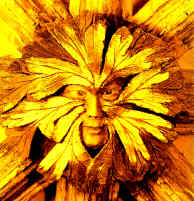
The name of this group probably will probably mean little to you until I tell you that it is a duo made up of Sean Breadin (better known on the storytelling scene as Sedayne) and his wife Rachel McCarron. I approached the CD with no preconceptions at all not having heard Sedayne. It was a surprise. It's different. It defies categories. I don't know how to review it without writing pages so the first thing I'm going to do is short-circuit that process by putting down a stream of consciousness string of words and ideas (which seems fitting): hypnotic; rhythmic; disconcerting; irritating; soothing; ancient; modern; not for the faint hearted; play it loud, late at night (when under the influence of strange substances if that's your thing); a tapestry of sounds; what the Incredible String Band might have sounded like if the technology had existed in 1967... or "Proximal Indo-European No-Age Exotica" as the notes say. Does that give you an idea of what to expect? I doubt it.
To attempt to put it into logical English: this is a CD of 7 tracks recorded between January and June of 2003. The songs were originally intended to make up 4 sides of vinyl but the U.S. company closed so instead they are on "the finest quality allblack Ritek CDRs hand produced to order".
Although there are only two musicians involved you could be forgiven for thinking there was a cast of hundreds including Asian drummers, heavenly choirs, medieval minstrels and Whirling Dervishes! The backings are a mixture of real and synthesised instruments and voices layered one upon the other to create soundscapes; in fact to tell the stories, because the words seem to be secondary to the overall effect. That works well on some tracks but is a pity on a couple of the big ballads, particularly Thomas the Rhymer and King Orfeo which do have powerful, wordy stories to tell. (The title is a refrain line from the latter song and means something along the lines of 'the wood is green yearly' )
My opinion of the album has fluctuated. On hearing the first couple of tracks I was fascinated, then I began to feel a bit disappointed, but after a few playings it has grown on me again. I don't like Thomas the Rhymer, it's too long, the tune is too repetitive and the voice is unsure in intonation, but the opening track Grow Grow Green Branch is a very catchy, dancy, upbeat number and I love Tempus Est Iocundum, a Latin chant which graphicly depicts sexual love in the rising of spring (apparently!); and the final instrumental track Epiphany which features some great trumpet. King Orfeo nearly does it for me; I like the backing (as they used to say on Juke Box Jury) but I wish I could hear the story better.
As well as the basic CD there are lots of extras: along with the main CD comes a second 1 supplementary' disc - 'fower muckle sangs' containing alternative, even longer versions of Thomas and Orfeo plus Tam Lin and Twa Corbies.
And to put it all into context there is also the website www.sedayne.co.uk/scowan which tells you all about it and on which you could spend hours looking at pictures and playing samples. All in all a serious work.
Pete Castle (Facts & Fiction / August 2005)
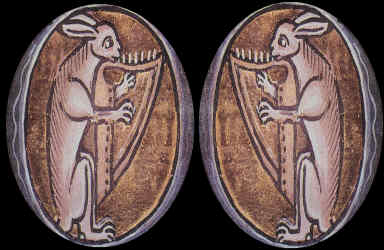
No, this isn’t an obscure album of medieval Lancashire dialect poetry! Actually, instead it’s Raymond, the illustrious Editor of Roundabout’s sister mag Stirrings, whom I must thank for alerting me to this strange but rather intriguing and stimulating release. It even comes with a free bonus CD “supplement” of traditional material, Four Muckle Songs, which contains epic (ie well over 15-minute) reworkings of (yes you’ve guessed it!) four classic ballads including Tam Lin. While the main CD, in 77 minutes, mixes Scottish ballads, neo-pagan chants and a 13th century sacred piece from the Carmina Burana. So VA’s seriousness of purpose is never in question then. Who on earth are they? you’re asking me; basically, they’re a Co. Durham-based duo (Sean Breadin and Rachel McCarron), who term themselves musical storytellers; between them, they sing, chant, sample and play various instruments (some, like the gardon, koboz and crwth, wilfully obscure) to a primeval drone and primitive beats. The music’s almost impossible to define, though it definitely has its roots in folk – in more than a roundabout sort of way (there Trevor, is that good enough for you?!) – and in medieval music, occasionally filtered through the ultra-modern trappings of electronic music and experimental jazz; the often peculiar vocal treatments give the whole exercise an air of old-age new-age occult weirdness that’s actually perversely appealing. Antiquity and tradition reinterpreted for and by our own age, with no compromise but with artistic values resolutely intact. It’s disturbing and persistent yet also comfortingly familiar in places where you least expect. Time flies yet time stands still (I might punningly describe it as “trance-ient”!). A lot happens yet sometimes little seems to happen. Such paradoxes abound!… so if you’re keen now to investigate, get logged onto www.sedayne.co.uk pronto.
David Kidman (Folk Roundabout / Autumn 2005)
A decidedly strange but in the end rather wonderful and fascinating release. Its enterprise seemingly knows no bounds, for it even comes with a free bonus CD "supplement" of completely traditional material, Four Muckle Songs, which contains epic (ie well over 15-minute) reworkings of (yes you've guessed it!) four classic traditional ballads including Tam Lin. While the main CD, in 77 minutes, mixes Scottish ballads, neo-pagan chants and a 13th century sacred piece from the Carmina Burana. (Two of the ballads on the bonus CD are unedited versions of tracks from the main CD, but who's complaining, for the playing time's more than generous!) This release is subtitled "seven songs for the turning year", and its title couplet translates as "Early green's the wood where the stag runs yearly". But first, who on earth are the somewhat impenetrably-named Venereum Arvum? Well it's a Co. Durham-based duo (Sean Breadin and Rachel McCarron), who term themselves musical storytellers; between them they sing, chant, sample and play various instruments (some, like the gardon, koboz and crwth, being almost wilfully obscure) to what generally amounts to a primeval drone and/or primitive beats. The music's almost impossible to define (though VA's own tag "idiomatic Mediaeval-Sephardic Proximal exotica" is a neat approximation!), as it very definitely has its roots in folk and in medieval music, but these are occasionally also filtered through the ultra-modern trappings of electronic music and experimental jazz (there's some Don-Cherry-like brass work for example). You can glean further clues from the sometimes cryptic liner notes, which are published not in the DVD-style case housing the CDs but on the below-mentioned website. For instance, "Thomas The Rhymer represents a different approach to traditional balladry; beginning with pure unaccompanied singing, the song becomes woven into the xenochronology using certain crwth loops…" See what I mean?… Whatever, the explications are most persuasive. Thomas aside, there's Tam Lin, on which a disturbingly atonal, disembodied vocal line seems to be travelling down to us through the dust of centuries, and King Orfeo which sinisterly conjures up something nasty coming through the Stargate from an ancient world. Then there's the contrasting Gothic soundscape of Twa Corbies, with its wheeling birdcalls on whistle and a churchy organ weaving snatches of the Dies Irae in and through the texture. On many tracks, the often uncompromisingly peculiar vocal treatments give the whole exercise an air of old-age new-age occult weirdness that's actually perversely appealing. Antiquity and tradition reinterpreted for and by our own age, with no compromise but with artistic values resolutely intact. It's disturbing and persistent yet also comfortingly familiar in places where you least expect. Time flies yet time stands still (one might punningly describe it as "trance-ient"!). A lot happens yet sometimes very little seems to be happening. Such paradoxes abound! At times you can imagine the Third Ear Band plugging into White Noise, or Anthems In Eden and the stranger mythical meanderings of Robin Williamson colliding with Laurie Anderson's vocoder treatments… Keen to investigate? I was, and I'm sure that by now you're sufficiently intrigued to want to know more.
David Kidman Autumn 2005 ( www.netrhythms.co.uk/reviews.html )
